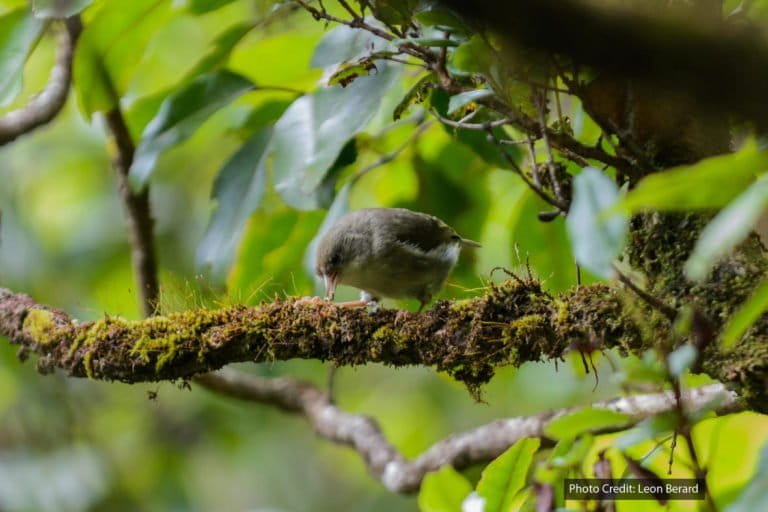- A warmer climate has allowed mosquitoes that carry avian malaria to invade honeycreeper habitats on the Hawaiian island of Kaua’i.
- Honeycreeper populations have decreased as much as 98 percent over the past 15 years.
- Unless ecologists intervene, the birds may vanish in 10 to 30 years.
In the rugged mountain forests of Kaua’i, colorful birds called honeycreepers are dying out. Usually protected by the cooler temperatures found at higher altitudes, the birds are now victims of malaria-carrying mosquitoes that have crept upward as temperatures rise.
Honeycreeper populations declined an average of 68 percent in the core of their preferred range on Kaua’i and 94 percent at the fringes of their habitat over the past 15 years, researchers reported recently in Science Advances. “The most recent data show a greatly accelerated decline in the entire avian community. And that’s pretty surprising,” said lead author Eben Paxton, an avian ecologist at the U.S. Geological Survey Pacific Island Ecosystems Research Center in Hawai’i National Park, Hawai’i.

The invasive mosquitoes are also reducing the geographic range of the birds, forcing them into ever-smaller areas. The honeycreeper is plummeting towards extinction within the next 10 to 30 years unless ecologists can reverse the trends, Eben’s team believes.
Honeycreepers are unique to Hawai’i and have a special place in the heart of Hawaiians and ecologists alike. In native Hawaiian culture, the birds are considered spiritual guides for families; their feathers are symbols of power. For ecologists, honeycreepers are an impressive example of adaptive radiation. A single species of finch arrived at the Hawaiian Islands millions of years ago, then evolved into 50 or 60 species of honeycreepers with myriad colors and shapes of bills.
“A lot of people say that if Darwin had landed on Hawai’i instead of the Galapagos, he would have come up with the theory of natural selection a lot quicker,” said Paxton.

Avian malaria and mosquitoes didn’t exist in Hawai’i until the 1800s. When ships landed on the islands and exchanged their drinking water, sailors inadvertently dumped mosquito larvae into freshwater streams. Avian diseases, including malaria, then arrived with caged birds. Mosquitoes fed on the birds with malaria, creating a new disease-carrying insect.
As climate change warms the planet, mosquito habitats increase. Surprisingly, less rain—another byproduct of climate change in some regions—makes the problem worse. In the past, large rainstorms would scour out mosquito larvae living in natural pools on Kaua’i. But the island has been drier than normal in the past 15 years, so more larvae have persisted. Anouk Glad, a vector ecologist formerly at University of Hawai’i at Manoa in Honolulu, said warmer temperatures can strongly influence how mosquito larvae develop and how malaria spreads, both to the detriment of the honeycreeper.
Paxton said Kaua’i is the “honeycreeper in the coal mine” for understanding how to combat insect-borne diseases in a warmer world. “Whatever strategy we develop in Kaua’i is something we can use on other islands and mountain ranges where species don’t have room to migrate away from pressures,” he said.

To combat avian malaria, researchers can focus either on bolstering the birds’ resistance to the disease or reducing mosquito populations. Because of human health issues like malaria and the Zika virus, Paxton said scientists have more experience in fighting mosquitoes.
Glad agrees that controlling mosquitos is the best option, but in the rugged and steep forest on Kaua’i, this will be difficult. Glad suggests protecting honeycreepers from predation and habitat intrusion might also help the birds successfully raise offspring. “The main hope here is to give more time for the remaining birds to evolve resistance,” said Glad, who was not involved with the study.
Honeycreepers will go extinct on Kaua’i unless people act quickly, Paxton warned. “It’s going to take resources and commitment by society to do what it takes to save these birds,” he said. “But if we do it soon and with sufficient effort, we can turn this sad story and give it a happy ending.”

Citation:
Paxton, E. H., Camp, R. J., Gorresen, P. M., Crampton, L. H., Leonard Jr., D, L., and VanderWerf, E. A. “Collapsing avian community on a Hawaiian island.” Science Advances 2, e1600029 (2016). doi:10.1126/sciadv.1600029.
Sarah Derouin is a graduate student in the Science Communication Program at the University of California, Santa Cruz. Other Mongabay stories produced by UCSC students can be found here.